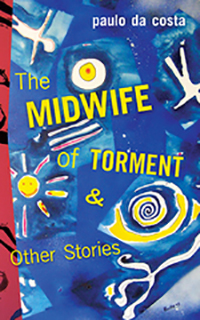Reviews
Fiction Review by Sean Johnston
paulo da costa, The Midwife of Torment and Other Stories (Oakville: Guernica, 2017). Paperbound, 150 pp., $20.00.
 The Midwife of Torment and Other Stories is paulo da costa’s third book of fiction in English; his previous books include fiction--The Green and Purple Skin of the World (Freehand 2013) and Scent of a Lie (Ekstasis 2002)—and a collection of essays called Beyond Bullfights and Ice Hockey (Boavista 2015). He has also published poetry and fiction in Portuguese and translated into English the poetry of Nuno Judice, published as the collection The Cartography of Being (Livros Pé D'orelha 2012).
The Midwife of Torment and Other Stories is paulo da costa’s third book of fiction in English; his previous books include fiction--The Green and Purple Skin of the World (Freehand 2013) and Scent of a Lie (Ekstasis 2002)—and a collection of essays called Beyond Bullfights and Ice Hockey (Boavista 2015). He has also published poetry and fiction in Portuguese and translated into English the poetry of Nuno Judice, published as the collection The Cartography of Being (Livros Pé D'orelha 2012).
This book is a collection of sudden fiction, sixty stories in all, divided into six sections called “Affections,” “Slowness,” “Beneath Our Beds,” “Aqua Libera,” “Force,” and “Fathers.” In one story, “The Wait,” a dog waits for its owner to come home from work and is told from the dog’s perspective. In another, “Long Run,” a mosquito and a jogger have a conversation in which she tries to persuade him to allow her to bite; in another, “A Perfect and Pleasant Day,” a cyclist in the Tour de France is revealed to be an average person in a training session enhanced by a virtual reality program. The pieces are generally of two types. The first is a narration of one character alone, whose isolation inspires pity or admiration depending upon the particular story. This first type is generally in the realist mode. The second type, in which there are two or more characters and more time elapses, are fable-like, and more successful.
In the two-page story “The Wall Mover,” a bedtime ritual, in which a boy plays a superhero and his father pretends the boy’s powers are real, ends up ruining his life when he blames himself for an earthquake that kills thousands of people. The story raises a universal and difficult question: how much magic is too much? We need the imagination, but does giving it too much power make us powerless in the material world? I would have loved to be left with that question. Instead, the story ends with an address to the reader, making explicit the teaching purpose of the fable: “You may see Rocco in your early morning walk to work as he rolls up his foam mat and wool blanket on a park bench; he will lower his gaze to the ground to avoid yours, ashamed of the harm and pain he has caused, for he knows no one was left untouched by the tragedy of his foolish childhood dream coming true.” What a story it might have been had it not distanced both the narrator and the reader from the broken character of Rocco with this sentimental gesture that teaches us what most of us already know: every wounded and unlucky person we meet was once a child who believed in magic. The story contains a beautiful and mysterious moment, but then goes too far, as too many of the pieces do.
At its best, the fiction in da costa’s book inhabits a local world and describes a scene that is natural and universal. At its worst, it’s moralizing and distanced, even didactic. Too often, the narrator has contempt for the average people and idealizes the actions of one, presented as too enlightened to live fully among them. The story “Treed,” for instance, is from the point of view of a tree that would like the jogger that runs by it and through the forest every day to slow down and be more tree-like; we are meant to understand that speed leads to ignorance and emptiness—a theme at the book’s centre.
Sometimes even in the briefest pieces, more brevity would help. Sometimes the thematic repetition mars our reading. “Sophia’s Longing,” shows both the potential of sudden fiction, and its challenges. The one-sentence story is by far the shortest in the book. Here it is: “The day Sophia slid into bed with the other man, she had bought a pair of hand-knitted socks to fit a new-born.” The uncertainty here could be intriguing. We don’t know the purpose of the socks; they may be a gift for another’s baby. Perhaps they were purchased in a hopeful gesture, for no specific baby. We don’t know anything about Sophia’s relationship to the man not in the story, linked to her by the word “other.” While this sort of ambiguity still fails, in my mind (even with all the possibilities, the story is too slight), it is severely diminished by the moralizing tone of the whole collection. The story is meant to surprise by revealing Sophia’s infidelity, and we know this by the sententiousness of so much of the book.
In the book’s acknowledgments, da costa tells us these pieces were written about twenty years ago, while he composed his first book, The Scent of a Lie. That makes sense, as they seem often to be just sketches, not finished pieces, and may illuminate a reading of that book. . For those new to da costa’s work, I recommend starting with The Green and Purple Skin of the World; it’s his best work, and Midwife’s appeal is strengthened by its relationship to his previous work.
—Sean Johnston









